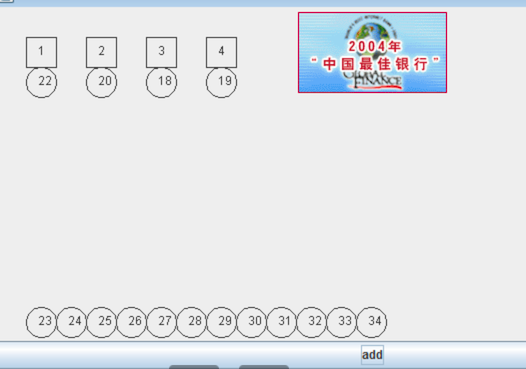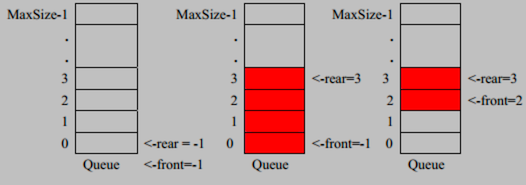数据结构与算法——队列(环形队列)
一个使用场景
银行办理业务的排队叫号

办理业务的人先拿号,然后窗口叫号处理,没有叫到的,则排队等待。
基本介绍
队列:是一个 有序列表,可以用 数组 或 链表 实现。
特点:遵循 先入先出 原则。即:先存入的数据,先取出。
示意图:

- front:队首,队列头部
- rear:队尾,队列尾部
- 左 1 图:队列初始化的两个变量值
- 中图:存入数据后,的首位变化
- 右图:取数据时,从队首取,队首的变量指向也在发生变化
数组模拟队列
队列本身是 有序列表,使用数组结构来存储队列的数据,则如前面基本介绍中的示意图一样。
声明 4 个变量:
arr:用来存储数据的数组maxSize:该队列的最大容量front:队首下标,随着数据输出而改变rear:队尾下标,随着数据输入而改变
队列中常用操作分析,以 add,把数据存入队列为例,思路分析:
- 将尾指针往后移:
rear + 1,前提是当front == rear时,队列是空的 - 若尾指针
rear < maxSize -1:- 则将数据存入 rear 所指的数组元素中,
- 否则无法存入数据。
rear = maxSize -1表示队列满了
以上思路是一个最基本的实现(不是完美的,看完代码就明白了)。代码实现如下
/**
* 数组模拟队列
*/
public class ArrayQueueDemo {
public static void main(String[] args) {
ArrayQueue queue = new ArrayQueue(3);
queue.add(1);
queue.add(2);
queue.add(3);
System.out.println("查看队列中的数据");
queue.show();
System.out.println("查看队列头数据:" + queue.head());
System.out.println("查看队列尾数据:" + queue.tail());
// queue.add(4);
System.out.println("获取队列数据:" + queue.get());
System.out.println("查看队列中的数据");
queue.show();
}
}
class ArrayQueue {
private int maxSize; // 队列最大容量
private int front; // 队列头,指向队列头的前一个位置
private int rear; // 队列尾,指向队列尾的数据(及最后一个数据)
private int arr[]; // 用于存储数据,模拟队列
public ArrayQueue(int arrMaxSize) {
maxSize = arrMaxSize;
arr = new int[maxSize];
front = -1;
rear = -1;
}
/**
* 取出队列数据
*/
public int get() {
if (isEmpty()) {
throw new RuntimeException("队列空");
}
return arr[++front];
}
/**
* 往队列存储数据
*/
public void add(int n) {
if (isFull()) {
System.out.println("队列已满");
return;
}
arr[++rear] = n;
}
/**
* 显示队列中的数据
*/
public void show() {
if (isEmpty()) {
System.out.println("队列为空");
return;
}
for (int i = 0; i < arr.length; i++) {
System.out.printf("arr[%d] = %d \n", i, arr[i]);
}
}
/**
* 查看队列的头部数据,注意:不是取出数据,只是查看
*
* @return
*/
public int head() {
if (isEmpty()) {
throw new RuntimeException("队列空");
}
return arr[front + 1]; // front 指向队列头前一个元素,取头要 +1
}
/**
* 查看队尾数据
*
* @return
*/
public int tail() {
if (isEmpty()) {
throw new RuntimeException("队列空");
}
return arr[rear];
}
// 队列是否已满
private boolean isFull() {
return rear == maxSize - 1;
}
// 队列是否为空
private boolean isEmpty() {
return rear == front;
}
}
运行测试
查看队列中的数据
arr[0] = 1
arr[1] = 2
arr[2] = 3
查看队列头数据:1
查看队列尾数据:3
获取队列数据:1
查看队列中的数据
arr[0] = 1
arr[1] = 2
arr[2] = 3
分析
目前实现了一个 一次性的队列(不能复用),因为可以往队列中添加数据,基本功能也是可以的,当队列满之后,再添加就加不进去了,获取数据也不能清空原队列中的数据。
优化方向:使用算法将这个数组改进成一个环形队列。
数组模拟环形队列
思路分析

-
front:含义调整
表示:队列的第一个元素,也就是说
arr[front]就是队列的第一个元素初始值:0
-
rear:含义调整
表示:队列的最后一个元素的下一个位置
初始值(只是初始值):0
这个很重要,是一个小算法,能更方便的实现我们的环形队列。
-
队列 满 计算公式:
(rear + 1) % maxSize == front -
队列 空 计算公式:
rear == front -
队列中 有效元素个数 计算公式:
(rear + maxSize - front) % maxSize
为了能更清晰这个算法,下面画图来演示队列中元素个数,关键变量的值

该算法取巧的地方在于 rear 的位置,注意看上图,rear 所在的位置 永远是空的,实现环形队列的算法也有多种,这里空出来一个位置,是这里算法的核心。所以,循环队列会浪费一个数组的存储空间。
代码实现
/**
* 数组拟环形队列
*/
public class CircleQueueDemo {
public static void main(String[] args) {
CircleQueue queue = new CircleQueue(3);
// 为了测试方便,写一个控制台输入的小程序
Scanner scanner = new Scanner(System.in);
boolean loop = true;
char key = ' '; // 接受用户输入指令
System.out.println("s(show): 显示队列");
System.out.println("e(exit): 退出程序");
System.out.println("a(add): 添加数据到队列");
System.out.println("g(get): 从队列取出数据");
System.out.println("h(head): 查看队列头的数据");
System.out.println("t(tail): 查看队列尾的数据");
System.out.println("p(isEmpty): 队列是否为空");
while (loop) {
key = scanner.next().charAt(0);
switch (key) {
case 's':
queue.show();
break;
case 'e':
loop = false;
break;
case 'a':
System.out.println("请输入要添加到队列的整数:");
int value = scanner.nextInt();
queue.add(value);
break;
case 'g':
try {
int res = queue.get();
System.out.printf("取出的数据是:%d\n", res);
} catch (Exception e) {
System.out.println(e.getMessage());
}
break;
case 'h':
try {
int res = queue.head();
System.out.printf("队首数据:%d\n", res);
} catch (Exception e) {
System.out.println(e.getMessage());
}
break;
case 't':
try {
int res = queue.tail();
System.out.printf("队尾数据:%d\n", res);
} catch (Exception e) {
System.out.println(e.getMessage());
}
break;
case 'p':
System.out.printf("队列是否为空:%s", queue.isEmpty());
break;
}
}
}
}
class CircleQueue {
private int maxSize; // 队列最大容量
private int front; // 队列头,指向 队头 的元素
private int rear; // 队列尾,指向 队尾 的下一个元素
private int arr[]; // 用于存储数据,模拟队列
public CircleQueue(int arrMaxSize) {
maxSize = arrMaxSize + 1;
arr = new int[maxSize];
front = 0;
rear = 0;
}
/**
* 取出队列数据
*/
public int get() {
if (isEmpty()) {
throw new RuntimeException("队列空");
}
// front 指向的是队首的位置
int value = arr[front];
// 需要向后移动,但是由于是环形,同样需要使用取模的方式来计算
front = (front + 1) % maxSize;
return value;
}
/**
* 往队列存储数据
*/
public void add(int n) {
if (isFull()) {
System.out.println("队列已满");
return;
}
arr[rear] = n;
// rear 指向的是下一个位置
// 由于是环形队列,需要使用取模的形式来唤醒他的下一个位置
rear = (rear + 1) % maxSize;
}
/**
* 显示队列中的数据
*/
public void show() {
if (isEmpty()) {
System.out.println("队列为空");
return;
}
// 打印的时候,需要从队首开始打印
// 打印的次数则是:有效的元素个数
// 获取数据的下标:由于是环形的,需要使用取模的方式来获取
for (int i = front; i < front + size(); i++) {
int index = i % maxSize;
System.out.printf("arr[%d] = %d \n", index, arr[index]);
}
}
/**
* 查看队列的头部数据,注意:不是取出数据,只是查看
*
* @return
*/
public int head() {
if (isEmpty()) {
throw new RuntimeException("队列空");
}
return arr[front];
}
/**
* 查看队尾数据
*
* @return
*/
public int tail() {
if (isEmpty()) {
throw new RuntimeException("队列空");
}
// rear - 1 是队尾数据,但是如果是环形收尾相接的时候
// 那么 0 -1 就是 -1 了,负数时,则是数组的最后一个元素
return rear - 1 < 0 ? arr[maxSize - 1] : arr[rear - 1];
}
// 队列是否已满
private boolean isFull() {
return (rear + 1) % maxSize == front;
}
// 队列是否为空
public boolean isEmpty() {
return rear == front;
}
// 有效个数
public int size() {
return (rear + maxSize - front) % maxSize;
}
}
运行测试功能输出
s(show): 显示队列
e(exit): 退出程序
a(add): 添加数据到队列
g(get): 从队列取出数据
h(head): 查看队列头的数据
t(tail): 查看队列尾的数据
p(isEmpty): 队列是否为空
a
请输入要添加到队列的整数:
10
a
请输入要添加到队列的整数:
20
a
请输入要添加到队列的整数:
30
s
arr[0] = 10
arr[1] = 20
arr[2] = 30
a
请输入要添加到队列的整数:
40
队列已满
h
队首数据:10
t
队尾数据:30
g
取出的数据是:10
s
arr[1] = 20
arr[2] = 30
a
请输入要添加到队列的整数:
40
s
arr[1] = 20
arr[2] = 30
arr[3] = 40
h
队首数据:20
t
队尾数据:40
g
取出的数据是:20
s
arr[2] = 30
arr[3] = 40
a
请输入要添加到队列的整数:
50
s
arr[2] = 30
arr[3] = 40
arr[0] = 50
h
队首数据:30
t
队尾数据:50
可以看到上面的表现,和那个图解分析是一致的, rear 所在的位置没有元素,是动态的。



 浙公网安备 33010602011771号
浙公网安备 33010602011771号